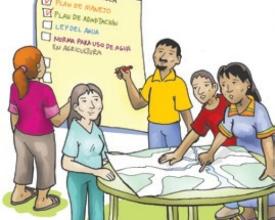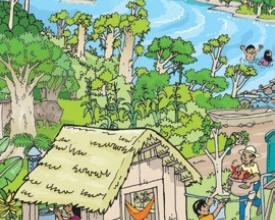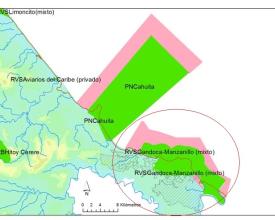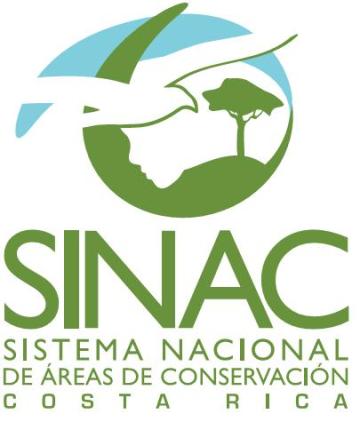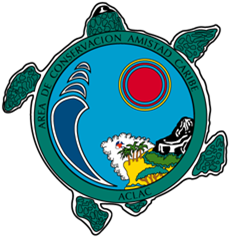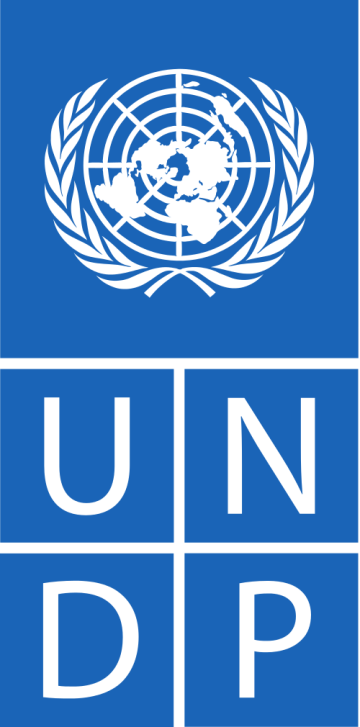
Las comunidades costeras combaten el cambio climático
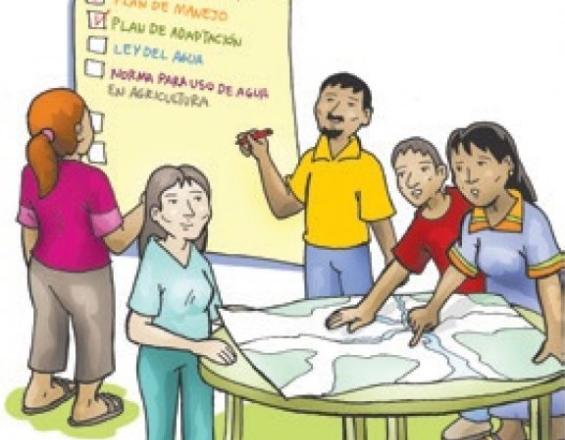
En Costa Rica existen muchas zonas de amortiguamiento alrededor de áreas protegidas con altos valores de biodiversidad, alto potencial para la implementación de estrategias de adaptación basadas en soluciones naturales, y en las que se presentan "vacíos de conservación". Esta solución buscaba mejorar la gestión participativa del Refugio de Vida Silvestre Gandoca Manzanillo (RVSM), en la costa caribeña de Costa Rica, señalando la importancia del capital social para fortalecer la resiliencia de las comunidades locales y las partes interesadas.
Contexto
Défis à relever
Ubicación
Procesar
Bloques de construcción
Objetivos prioritarios de gestión
Las acciones de conservación, u "objetivos focales de gestión", para las áreas en torno a la RMG se identificaron y priorizaron utilizando datos biológicos, así como percepciones sociales sobre el estado y la importancia de estos objetivos. Las percepciones vienen determinadas por el grado de dependencia, tanto actual como histórica, que los agentes locales tienen de esos objetivos. El ejercicio de priorización también tiene en cuenta características clave como los valores ecológicos, la representatividad, la capacidad de influir en otros objetivos focales de gestión, las amenazas y la relevancia para la mejora de los medios de subsistencia locales, y sirve de guía para la designación de recursos al tiempo que ayuda a acercar las preocupaciones locales a los objetivos de gestión de las áreas protegidas / zonas de amortiguamiento. Las amenazas que afectan a cada objetivo también fueron identificadas y evaluadas por expertos y comunidades.
Factores facilitadores
- Los expertos locales y nacionales conocen el lugar.
- Se dispone de conocimientos científicos y empíricos.
- Existe autoridad de gestión con personal in situ responsable de la gestión.
Lección aprendida
Introducir el concepto de "objetivos focales de gestión" con expertos y población local requirió tiempo y explicaciones, pero ayudó a integrar tanto los conocimientos técnicos como los empíricos locales disponibles. Reconocer el valor de los conocimientos de la población local sobre la situación e importancia de los "objetivos focales de gestión" y sus amenazas facilitó su participación y compromiso en el proceso.
Indicadores sociales
La eficacia de la conservación de los recursos naturales en las áreas protegidas está estrecha y directamente vinculada a la eficacia de las estrategias de comunicación y coordinación de las partes interesadas. Sin embargo, los esfuerzos de acercamiento social suelen producirse dentro de los límites de las áreas protegidas, sin tener en cuenta a los actores situados en las áreas de influencia o zonas tampón. En el caso de la GMWR y las "zonas de vacío de conservación" circundantes, era importante evaluar y mejorar la eficacia de las actuales estrategias de comunicación y generar confianza para facilitar el diálogo en torno al área protegida. Para ello, se desarrolló una nueva metodología, utilizando un conjunto de 6 indicadores posicionales y globales basados en el papel social de cada actor (nodos). La información se recopiló a través de varias actividades participativas, como talleres comunitarios y consultas individuales con líderes comunitarios locales y representantes del gobierno. Los datos se analizaron con los programas matemáticos y gráficos UCINET y Net Draw. Cada actividad tenía como objetivo revisar y actualizar los progresos realizados y llegar a acuerdos sobre las fases siguientes; estos pasos iterativos aumentaron la sensación de transparencia y apertura del proceso que se estaba llevando a cabo.
Factores facilitadores
- Redes locales y subregionales de comunicación y coordinación.
- Grupos comunitarios organizados existentes en la zona.
- Interés de las comunidades y el gobierno por comprender las características de sus redes sociales actuales.
- Voluntad y experiencia de las partes interesadas locales para cooperar.
- La autoridad de gestión reconoce la necesidad del compromiso local.
- Se dispone de conocimientos científicos y empíricos.
- La autoridad de gestión y el personal in situ son responsables de la gestión.
Lección aprendida
- Generar confianza entre la población local aumentó su disposición a participar, y seguir participando, en el proceso.
- Medir la actividad social, los niveles de confianza de los demás hacia cada grupo social y el poder de intermediación del grupo social son tres variables clave que pueden ayudar a evaluar el papel social de los grupos de interesados.
- Es posible medir la intención de los grupos de partes interesadas de crear asociaciones con otros grupos de la zona. Algunos grupos centran sus esfuerzos en asociaciones con grupos de fuera de la zona (a escala nacional o internacional); sólo una minoría de grupos tiene la intención positiva de crear asociaciones entre ellos.
- Es urgente comprender la importancia de la conectividad social y las características de las redes de comunicación y cooperación.
- Los talleres comunitarios son un buen medio para fomentar el compromiso y también para desarrollar capacidades mediante la concienciación y el intercambio de información. Lo mejor es que estos talleres hagan ambas cosas, ofrecer y captar información.
Redes de comunicación y coordinación
El enfoque aplicado en la GMWR permitirá integrar no sólo la información científica y comunitaria, sino también las percepciones locales (que históricamente tienden a quedar relegadas a un segundo plano) sobre los objetivos prioritarios de gestión y en la caracterización de las formas y medios de comunicación local. Estos aspectos sociales pueden integrarse ahora en los instrumentos oficiales de gestión, como elementos esenciales de la estrategia necesaria para abordar las lagunas de conservación en torno a la RMG. Para que dicha estrategia sea eficaz, debe englobar una estrategia de participación pública diseñada a partir de las conclusiones anteriores (4.1 y 4.2). A su vez, para que esta estrategia de participación sea sólida y receptiva, debe considerar el análisis cuantitativo y cualitativo de las redes de comunicación y coordinación existentes, y proponer medios para fortalecer y consolidar estas redes. Esto es crucial, dada la constatación de que existe una correlación directa entre la densidad y el poder de las redes sociales en las comunidades costeras, y la eficacia de las acciones de conservación en estas zonas.
Factores facilitadores
- Redes locales y subregionales de comunicación y coordinación.
- Colaboración y compromiso de los actores en todas las fases del proyecto.
- Experiencias previas de participación social llevadas a cabo en la zona, cuyos resultados facilitaron un análisis comparativo de los puntos fuertes y débiles de dichos procesos.
- Voluntad y experiencia de los actores locales para cooperar.
- Reconocimiento por parte de la autoridad de gestión de la necesidad de participación local.
- Disponibilidad de conocimientos científicos y empíricos.
Lección aprendida
- Si bien la conectividad ecológica es clave para estos ecosistemas, la conectividad social y la coordinación son vitales para mejorar la gestión y el estado del área protegida.
- Los resultados revelaron conclusiones interesantes en relación con las redes que fomentan la participación:
- Éstas pueden verse influidas no sólo por las dinámicas sociales y socioambientales dentro de los límites del área protegida, sino también por las características de las redes externas con las que se conectan sus integrantes.
- Las redes construidas a partir de vínculos débiles, informales o flexibles son, en la mayoría de los casos, importantes generadores potenciales de capital social, indispensable para potenciar los procesos de participación.
- Las redes de participación con altos grados de centralización son vulnerables a la desintegración debido a factores de perturbación externos o internos. Por esta razón, el fortalecimiento de las capacidades de liderazgo y la promoción de nodos facilitadores son claramente importantes.
Impactos
Mediante la aplicación de una herramienta innovadora para evaluar y mejorar la comunicación y la creación de alianzas entre las partes interesadas locales, se espera establecer comunidades más resistentes a los impactos del cambio climático. Las comunidades están participando activamente en la identificación de actividades para reducir la vulnerabilidad al cambio climático, con los beneficios derivados para el GMWR. Se espera que las comunidades sigan participando en la ejecución de las acciones de conservación identificadas conjuntamente y mantengan su compromiso de mantener vivas las nuevas asociaciones. Así pues, garantizar la integración del capital social en las estrategias de gestión de las zonas tampón puede ofrecer una solución inspiradora no sólo para la biodiversidad, sino también para los medios de subsistencia y el reconocimiento de los conocimientos de las comunidades locales. Esto, a su vez, se convierte en un medio para aumentar la resiliencia al cambio climático de las comunidades y ecosistemas costeros. La herramienta desarrollada para el GMWR ofrece una base de buenas prácticas en el diseño de estrategias de gestión participativa para otras áreas protegidas / zonas de amortiguamiento, ya que permite soluciones medioambientales que se adaptan mejor a las necesidades de conectividad institucional, social y ecológica, y a las realidades de cada área protegida.
